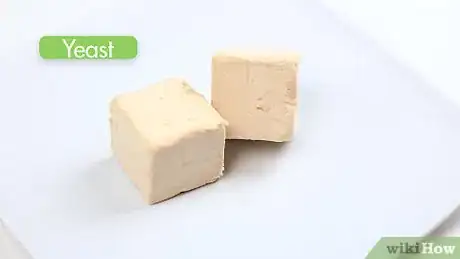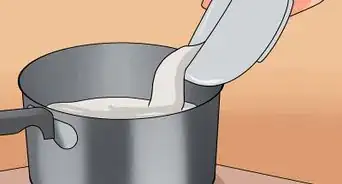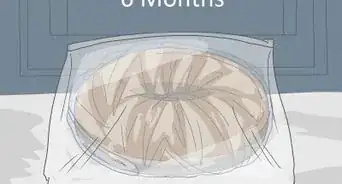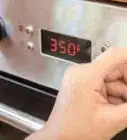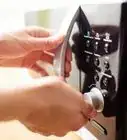wikiHow is a “wiki,” similar to Wikipedia, which means that many of our articles are co-written by multiple authors. To create this article, volunteer authors worked to edit and improve it over time.
The wikiHow Video Team also followed the article's instructions and verified that they work.
This article has been viewed 267,829 times.
Learn more...
Fresh yeast is most often used by professional bakers because of its quality, vulnerability and short shelf life. Interested home bakers who can not find these tiny packaged cakes in the refrigerated section of their grocery may be able to obtain fresh yeast by requesting to purchase some from a local bakery. Yeast from fresh yeast cakes must be activated, or proofed, prior to being used in a recipe. If your yeast is not activated, the bread you are making will not rise.
Steps
-
1Check the freshness of fresh yeast. Your senses are all that is necessary to determine how fresh your fresh yeast is. The color should be consistently ivory with no dark spots or color alterations. The texture should be moist yet crumbly with no hard spots. The odor should smell pleasantly of yeast. If the yeast cake has dark spots or color alterations or has any hard spots, it has gone bad and should be discarded. Do not continue with your recipe until you have a new, fresh yeast cake.[1]
-
2Prepare fresh yeast to be used. Fresh yeast comes in a solid chunk or cake. Crumble the amount needed for your selected recipe into a bowl. You can also place the amount you need in the bowl and break it apart using a spoon.Advertisement
-
3Proof fresh yeast to activate it. Part of the purpose of proofing yeast is to give a final decree on determining its freshness. To activate fresh yeast, follow the process of feeding it and evaluating its response. Do not use yeast that does not respond to proofing.[2]
- Feed your fresh yeast. Yeast, similar to when a human or animal is fed, responds to the consumption of the food and water. Activate fresh yeast by mixing it with the warm water called for in the recipe and, if applicable, the sugar. The water must be at the perfect temperature between 90 and 100 degrees Fahrenheit (32 to 38 degrees Celsius). If the water is cooler, the yeast will not activate. If the water is hotter, the yeast will be killed. Add the warm water to the yeast in your bowl.[3]
- Stir the yeast and water mixture thoroughly. Stir until the yeast is dissolved completely. The texture may be a little thick and pasty.[4]
- Place the bowl in a warm location that is free from drafts. Yeast needs warmth in order to grow. Pay attention that the location is not so warm, however, that it kills or prematurely cooks the yeast.
- Wait. Yeast takes between 5 to 10 minutes to activate. It should be foamy or show signs of expansion.[5]
-
4Add your activated yeast to the remaining ingredients in your recipe.
Community Q&A
-
QuestionTwice I have bought fresh yeast from the supermarket within the use by date and I still cannot get it to work. What can I do?
 Community AnswerIs the water too hot, or are you adding salt? Both will kill the yeast. Also, look at how you're storing it before use. Is the area too hot? Is it in direct sunlight?
Community AnswerIs the water too hot, or are you adding salt? Both will kill the yeast. Also, look at how you're storing it before use. Is the area too hot? Is it in direct sunlight? -
QuestionWould I be better off using quick yeast or activating fresh yeast if I am new to baking bread?
 Community AnswerUse quick yeast, but carefully read the instructions and keep a close eye on it. You might find watching a "how to" video online in advance helpful.
Community AnswerUse quick yeast, but carefully read the instructions and keep a close eye on it. You might find watching a "how to" video online in advance helpful. -
QuestionHow do I store fresh yeast? Can I freeze it?
 Community AnswerYou can freeze it, but fresh yeast has shorter shelf life, so you should use it within two weeks.
Community AnswerYou can freeze it, but fresh yeast has shorter shelf life, so you should use it within two weeks.
Things You'll Need
- Yeast
- Warm water
- Sugar
- Bowl
- Spoon
References
- ↑ https://www.joyofbaking.com/Yeast.html
- ↑ https://www.bobsredmill.com/blog/healthy-living/how-to-proof-yeast/
- ↑ https://www.bbc.co.uk/food/techniques/using_fresh_yeast
- ↑ http://www.recipetips.com/kitchen-tips/t--1113/leavening-direct-or-straight-yeast-method.asp
- ↑ https://www.melskitchencafe.com/tutorial-working-with-yeast/
